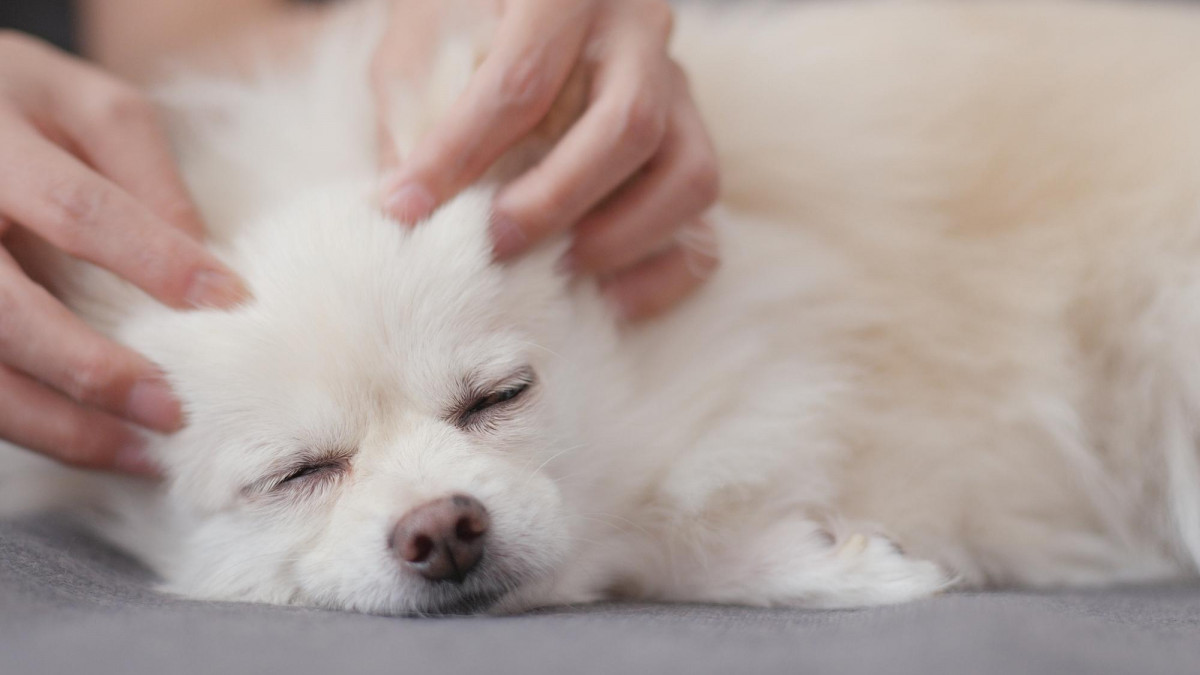For all the dogs who've touched our hearts
From screen to serene: massage to calm your dog

Massage is great for dogs: it boosts the immune system, stimulates circulation, reduces stress and feels good too.


Guest authors: Justis McLaren & Destiny G. Kelledy
Two Sisters Healing Arts offers Canine massage and training, focused on
growing connection between animals and the people who love them.


If you love someone, the greatest gift you can give them is your true presence.
Thich Nhat Hanh
Dream come true?
We may have assumed staying at home with our dogs by our side would be a dream come true. Well it is and it isn’t. The extra time we thought we’d have to relax is being filled by other obligations, giving us more time to worry. We’re experiencing more stress and less breaks than we might normally be getting in our daily routine. Our dog’s routine has also been changed a lot, and this can cause them stress.
If you’ve ever had a massage yourself, remember how much better you felt afterwards? Maybe you felt more relaxed and calm. With a few basic techniques, you can help your dog feel that way too. And you’ll feel better together.
The benefits of massage
Good for your dog
Massage can be helpful to our dogs in a lot of ways. Here are just a few.
- Boosts the immune system
- Stimulates circulation (good for older dogs)
- Releases endorphins and reduces stress
- Improves skin and coat
Massage moves fluids in the body, which helps keep cells hydrated and oxygenated. It encourages the removal of toxins and waste products.

Good for you
Massaging your dog helps you understand what is normal for them. When something changes, you’ll be the first to notice and can discuss concerns with their veterinarian. You’re learning about your dog through your hands. making you a better partner with your vet.
Research has shown that contact with our dogs can help lower our stress levels and blood pressure.

Good for both
Imagine, in only 10-15 minutes with your dog, you can let go of the tension of the day. This time together builds the bond between you, allowing you to be present with them.

Canine body basics
Muscles
Massage is all about the soft tissues of the body. When we think about muscles, we usually think of those used for movement. They are also critical for providing stability both in motion and in stillness (core muscles play this role).
Facia (pronounced fash'-uh)
Fascia is the thin, watery tissue that wraps muscles, organ and bones (how does an orange help explain fascia? Click on this link to find out!) When it is tight or dehydrated, it can restrict movement. Massage encourages this tissue to loosen which will help your dog’s muscles and skin be more elastic and have better fluidity.
Imagine a spider web – every part of the web is connected to the other parts, and when one strand is moved, the vibration can be felt along the whole web. This is similar to what fascia does. It is a connective tissue, but is also like a network through which everything is linked.
Ergonomics
Body posture
As you are working with your dog, try to keep your back comfortably straight. Be aware of the angles of your legs to your hips, and don’t overextend. If you sit on the floor, try sitting on a folded blanket to provide cushioning and slight elevation. If it is comfortable, and your dog is small enough, they can even be on your lap!
Read your dog
It’s important to pay very close attention to your dog’s feedback. If you are working in an area, and she starts to lick or puts her head over your hand, try moving away as that spot might be too sensitive for today. Watch her eyes – they should remain soft and relaxed, and not look worried or tight. You know your dog best, but it is still wise to place yourself in a position so that your face is well away from hers.
Remember, above all, they should have a choice to stay for the massage or leave. Many dogs will get up and wander and sniff before they decide this is okay and return for more. It’s not necessary for them to lie down. Signs they have enjoyed the time include shaking off (like after a bath), yawning or sighing. Not every dog is so relaxed afterwards that they take a nap – although some are!
Reasons not to massage
There are a number of reasons to skip a massage on a given day. If your dog has known health issues, check with your veterinarian first. Avoid massage if your dog has a fever, underlying medical condition such as cancer or is pregnant.

Rehearsal
Whenever possible, keep both hands on the dog even if only one is applying a massage stroke. The other hand will act as an anchor and grounding element.
The right pressure
In general, light pressure would be the amount you would apply to your eyelid, moderate pressure might be used to rub hand cream into your skin and deep pressure is making contact with tissue deeper below the skin. The amount of pressure you use depends on your dog and their condition. A light touch can be very stimulating. This might be good for an older dog who needs a boost of energy. A moderate amount of pressure is a good place to begin. Avoid deep pressure, as that isn’t necessary in most cases.
Speed
The right speed is important to find as well. Too fast, and it will become over-stimulating. Too slow can be irritating. There will be a “just right” for you and your dog, and it’s a good idea to experiment with this.
Practicing on yourself or others
To learn the most comfortable pressure, speed and duration, practice on yourself or another person – getting their feedback can be very helpful as you develop your skills.
The basic strokes
Effleurage – (pronounced eff’-lūr-aj) – This stroke doesn’t look much different to petting. A moderately light movement of the flat hand, done in the direction the fur grows.
Petrissage – This is the stroke most people think of when they think of massage. It is a kneading motion, and your fingers apply most of the pressure. This affects the tissue at a slightly deeper level under the skin and can help with tight muscles.
Tapping – The most common form of tapping that we use is a drumming technique. You’ll use your fingertips to tap in a somewhat rhythmic way on the dog – this is a good thing to try if their energy level is high in the beginning of the session.
Location
Allocate a special space
Know your dog – what do you think will work best for them? We recommend a relatively quiet space, comfortable for both of you. This should be an area free of distractions where your dog can relax.
Schedule during quiet time
Be thoughtful about the time of day you give a massage. It might be easier for your dog to settle after they’ve had a walk or some training time. Avoid the time before or directly after a meal. It’s important you feel calm for the session too.
The massage session



Tips as you get started
- Avoid putting any pressure on bony parts, especially over joints.
- Meet the energy of your dog – if they are very energetic at the start, make your movements slightly faster. Try using a bit of tapping and it may bring them to a more relaxed state.
- How long should the session last? 10 – 15 minutes is a great break for both of you.
- Most importantly – remember to breathe calmly.
Opening - exploring and saying hi
Begin with effleurage, as shown in the video. Do several passes across the entire body, feeling for areas of tension in the muscles, temperature differences (are some areas warmer than others?) and asking your dog if there is anything you should avoid. They may let you know simply by the look on their face about a sore spot.
Main part of the massage
If you have located some areas that are tight, you can do some light to moderate petrissage. If there aren’t specific areas of tension, you can still use these techniques for the neck, shoulders and rear legs.
However, don’t underestimate the benefit of effleurage. This technique alone can provide all the benefits mentioned above.
Closing
Once you have spent a few minutes working on specific areas, return to your effleurage, stroking the dog across their body again. This helps to connect their body with the work you have done.
After the session
If you discover anything that you want to check on again or discuss with your vet, make notes in a journal.
Make sure your dog has access to water afterwards.
Your dog may remain in place, get up and stretch or shake or yawn. These are all applause for what you have done.
Sometimes it goes differently
This is one version of a massage session – your experience may be much different. Different dogs have different responses to this work, and even if your dog loves it one time, they may not be the same on another day. What matters most is you spent time together connecting through massage.
DISCLAIMER: These techniques should never be used as a substitute for proper veterinary care. If you find any areas of concern, always call your veterinarian before continuing.
Two Sisters Healing Arts

Justis McLaren and Destiny Kelledy of Two Sisters Healing Arts are students of Northwest School of Animal Massage, currently learning about acupressure and specialized massage for performance canines. Justis has been studying dog training and behaviour for many years, and is a TAKL-certified trainer. Destiny is an artist and works in a variety of mediums. She has created art for Broadway charity and loves painting personalized animal portraits. They are focused on growing the connection between animals and the people that love them.
Destiny Kelledy: Bubbletraveler on Insta
Resources
The Dog Lover’s Guide to Massage by Megan Ayrault
Northwest School of Animal Massage Introductory Courses

You might also like

63118003bd067_lg.jpg)

Comments


Categories: : Health and welfare, Living with dogs
Comments
Never miss a thing!

 Two Sisters Healing Arts
Two Sisters Healing Arts 



